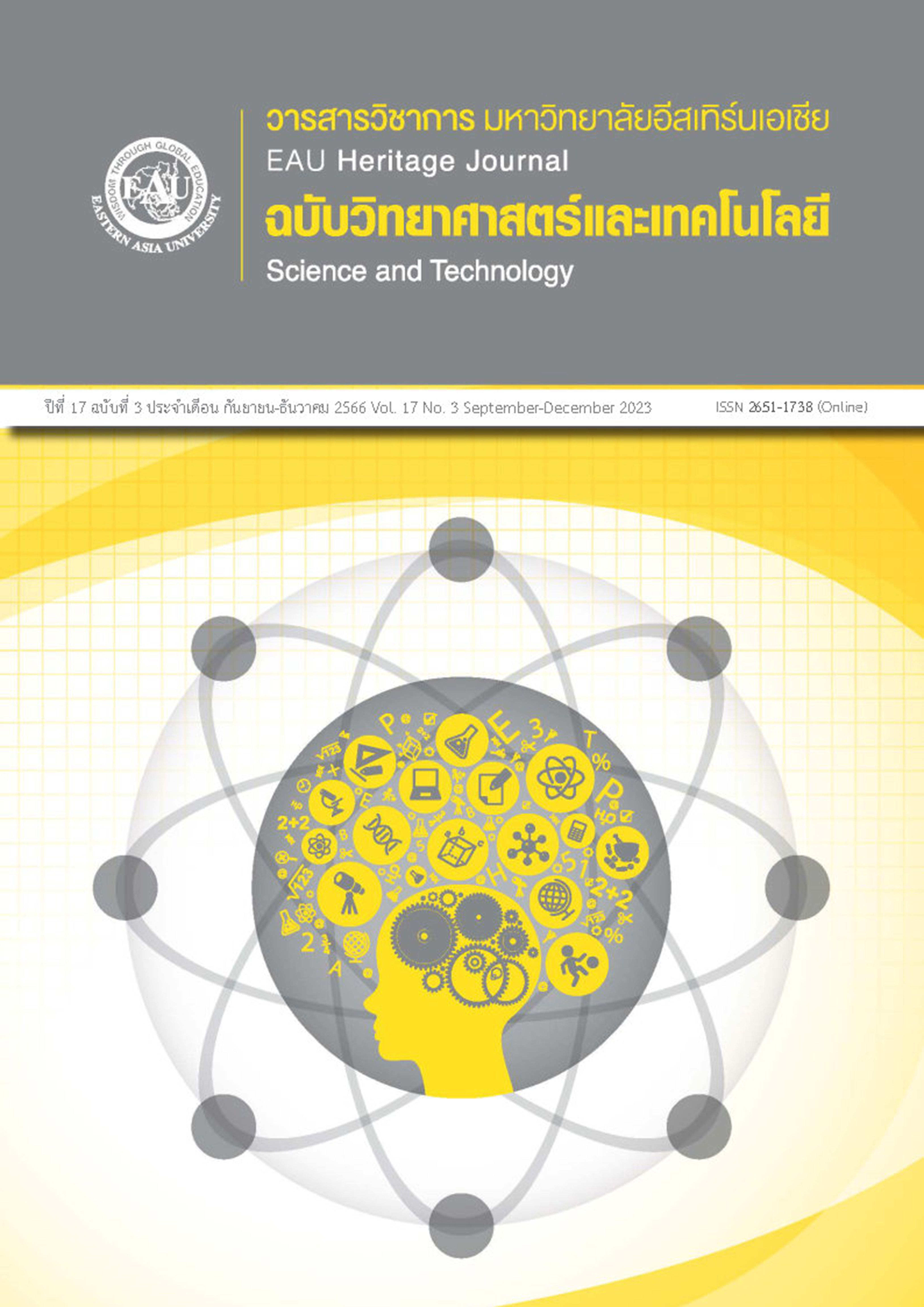การพัฒนาแบบจำลองพลังงานแบบบูรณาการของอาคารในเมืองพัทยา ประเทศไทย
คำสำคัญ:
อนุรักษ์พลังงาน, ประสิทธิภาพพลังงาน, การจำลองพลังงานในอาคาร, ลดการปล่อยก๊าซคาร์บอนไดออกไซด์บทคัดย่อ
การเปลี่ยนผ่านระบบพลังงานไปสู่ความเป็นกลางทางคาร์บอนนั้นจำเป็นที่จะต้องมีแนวความคิดหรือนวัตกรรมใหม่ ๆ สิ่งเหล่านี้สามารถเข้ามาช่วยสนับสนุนให้รัฐบาลท้องถิ่นและผู้ที่มีส่วนได้เสียในการกำหนดนโยบายด้านพลังงาน งานวิจัยนี้มีวัตถุประสงค์เพื่อพัฒนาและนำเสนอวิธีการในการสร้างแบบจำลองพลังงานอาคารแบบบูรณาการรวมถึงการวิเคราะห์มาตรการอนุรักษ์พลังงานและการปล่อยก๊าซคาร์บอนไดออกไซด์ที่เกี่ยวข้องกับพลังงานในเขตเมือง ในงานวิจัยได้ใช้เมืองพัทยาในประเทศไทยเป็นกรณีศึกษา โดยมีขอบเขตเฉพาะอาคารประเภทที่อยู่อาศัยเท่านั้น ผลการวิจัยพบว่า จากอาคารทั้ง 6 ประเภทอาคาร คือ (1) บ้านเดี่ยว (2) อาคารเดี่ยว (3) บ้านสองชั้น (4) ทาวน์เฮ้าส์ (5) อาคารพาณิชย์ และ (6) โรงแรมและคอนโดมิเนียม ในกรณีอ้างอิงมีการใช้พลังงานรวม 44,176,062 MWh/yr และการปล่อยก๊าซคาร์บอนไดออกไซด์รวม 25,714,886 tCO2e/yr การวิเคราะห์มาตรการการลดการใช้พลังงาน พบว่า การเปลี่ยนกระจกสองชั้นด้วยการเคลือบแบบ Low-E การติดตั้งฉนวนกันความร้อนที่ผนังและหลังคา ฟิล์มกันความร้อน และการติดตั้งแผงโซลาร์เซลล์บนชั้นดาดฟ้ามีศักยภาพสูงในการประหยัดพลังงานและลดการปลดปล่อยก๊าซคาร์บอนไดออกไซด์จากการใช้พลังงาน มาตรการเหล่านี้นำไปสู่การประหยัดพลังงานรวม 12,908,646 MWh/yr และลดปริมาณการปล่อยก๊าซคาร์บอนไดออกไซด์ได้ถึง 7,514,123 tCO2e/yr โดยวิธีการที่นำเสนอใช้สำหรับการตัดสินใจทางด้านพลังงานและความเป็นกลางทางคาร์บอนในเมืองจะเป็นประโยชน์ต่อรัฐบาลท้องถิ่นและผู้กำหนดนโยบายด้านพลังงาน
เอกสารอ้างอิง
Alhamwi, A., Medjroubi, W., Vogt, T., & Agert, C. (2019). Development of a GIS-Based platform for the allocation and optimisation of distributed storage in Urban Energy Systems. Applied Energy, 251, 113360. https://doi.org/10.1016/j.apenergy.2019.113360
Ali, U., Haris Shamsi, M., Hoare, C., Mangina, E., & O’Donnell, J. (2019). A data-driven approach for multi-scale building archetypes development. Energy and Buildings, 202, 109364. https://doi.org/10.1016/j.enbuild.2019.109364
Ali, U., Shamsi, M. H., Hoare, C., & O’donnell, J. (2018). GIS-Based residential building energy modeling at district scale. Proceedings of BSO 2018: 4th Building Simulation and Optimization Conference, Cambridge, UK: 11-12 September 2018 (pp. 153-160). UK: International Building Performance Simulation Association. http://www.ibpsa.org/proceedings/BSO2018/2B-2.pdf
ASHRAE. (2010). ASHRAE 90.1 appendix G: Building performance rating method. U.S.A.: ASHRAE
DOE. (2021). EnergyPlus, department of energy, energy.Gov. Retrieved from https://www.energy.gov/eere/buildings/articles/energyplus
Kampelis, N, Papayiannis, G. I., Kolokotsa, D., Galanis, G. N., Isidori, D., & Cristalli, C., & Yannacopoulos, A. N. (2020). An integrated energy simulation model for buildings. Energies, 13(5), 1170. https://doi.org/10.3390/en13051170
Li, C. (2018). GIS for urban energy analysis. In Comprehensive Geographic Information Systems Vol. 3 (pp. 187–195). Amsterdam, Netherlands: Elsevier.
Li, G., Xuan, Q., Akram, M. W., Akhlaghi, Y. G., Liu, H., & Shittu, S. (2020). Building integrated solar concentrating systems: A review. Applied Energy, 260, 114288. https://doi.org/10.1016/j.apenergy.2019.114288
Li, Y., Ding, D., Liu, C., & Wang, C. (2016). A pixel-based approach to estimation of solar energy potential on building roofs. Energy and Buildings, 129, 563–573. https://doi.org/10.1016/j.enbuild.2016.08.025
Marina, A., Soebarto, V., Williamson, T., Liang, R., Ebendorff-Heidepriem, H., & Wu, Y. (2019). Thermochromic smart window technologies for building application: A review. Applied Energy, 255, 113522. https://doi.org/10.1016/j.apenergy.2019.113522
Nutkiewicz, A., Yang, Z., & Jain, R. K. (2018). Data-driven Urban Energy Simulation (DUE-S): A framework for integrating engineering simulation and machine learning methods in a multi-scale urban energy modeling workflow. Applied Energy, 225, 1176-1189. https://doi.org/10.1016/j.apenergy.2018.05.023
Reinhart, C. F., & Davila, C. C. (2016). Urban building energy modeling–A review of a nascent field. Building and Environment, 97, 196-202. https://doi.org/10.1016/j.buildenv.2015.12.001
Pattaya City. (2019). Translation of Pattaya City yearly report 2019. Pattaya: Pattaya City. (in Thai)
Sola, A., Corchero, C., Salom, J., & Sanmarti, M. (2018). Simulation tools to build urban-scale energy models: A review. Energies, 11(12), 3269. https://doi.org/10.3390/en11123269
Stadler, M., Firestone, R., & Curtil, D. (2006). On-site generation simulation with energyplus for commercial buildings. Retrieved from https://escholarship.org/uc/item/7cf5g36q
UN DESA. (2018). 68% of the world population projected to live in urban areas by 2050, says UN. United Nations. Retrieved from https://www.un.org/development/desa/en/news/population/2018-revision-of-world-urbanization-prospects.html
Zhai, Y., Ma, Y., David, S. N., Zhao, D., Lou, R., Tan, G., Yang, R., & Yin, X. (2017). Scalable-manufactured randomized glass-polymer hybrid metamaterial for daytime radiative cooling. Science (New York, N.Y.), 355(6329), 1062–1066. https://doi.org/10.1126/science.aai7899
Zhang, Y., Ren, J., Pu, Y., & Wang, P. (2020). Solar energy potential assessment: A framework to integrate geographic, technological, and economic indices for a potential analysis. Renewable Energy, 149, 577–86. https://doi.org/10.1016/j.renene.2019.12.071







